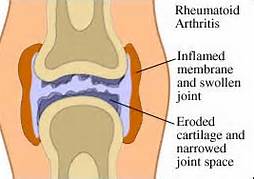Rheumatoid Arthritis

|
in health." George William Curtis |
Rheumatoid arthritis is a chronic inflammatory autoimmune disease afflicting an estimated 1.5 million Americans, the majority of which are women. RA affects just over 53 women per 100,000, compared to nearly 28 men per 100,000.
Rheumatoid arthritis is an autoimmune disease that causes your body to break itself down and the immune system mistakenly attacks healthy joint tissue and even the vital organs, causing inflammation in the synovial fluid of the joint. Unlike the wear-and-tear damage of osteoarthritis, rheumatoid arthritis affects the lining of your joints, causing a painful swelling that can eventually result in bone erosion and joint deformity.
Hundreds of thousands of people, mostly young women, are diagnosed with either lupus, rheumatoid arthritis, or both. Joint pains begin and quickly become intense, migrating throughout the joints of the body. A joint swell, turns red, hurt severely, and then becomes normal as another joint suffers the same problem.
Rheumatoid arthritis signs and symptoms may vary in severity and may even come and go. Periods of increased disease activity, called flares, alternate with periods of relative remission - when the swelling and pain fade or disappear. Over time, rheumatoid arthritis can cause joints to deform and shift out of place. Over time, the affected joints may become misshapen, misaligned and damaged. Tissue lining the joint can become thick, and may wear away surrounding ligaments, cartilage and bone as it spreads.
Some researchers believe an infection with a bacteria or virus can trigger the development of rheumatoid arthritis in someone who's genetically susceptible. However, to date, no infection or organism has been identified as the cause. When the body's immune system does not operate as it should, white blood cells that normally attack bacteria or viruses attack healthy tissue instead - in this case, the synovia, or joint tissue. As the synovial membrane (the thin layer of cells lining the joint) becomes inflamed, enzymes are released. Over time, these enzymes and certain immune cells damage the cartilage, bone, tendons and ligaments near the joint. As rheumatoid arthritis develops, some of the body's immune cells recognize one type of the person's own protein as a foreign intruder. The exact protein is unknown. Some of them are produced in response to infection, such as a viral, bacterial, or fungal infection. Other possible proteins may have a genetic connection or stem from other causes.
Whatever the source, cells called lymphocytes react to this protein. The reaction then causes the release of cytokines, which are chemical messengers that trigger more inflammation and destruction. With rheumatoid arthritis, the main target of inflammation is the synovia, the thin membrane that lines the joints. The inflammation also spreads to other areas in the body, ultimately causing not only joint damage but inflammation, chronic pain, fatigue, and loss of function.
Because rheumatoid arthritis is a systemic disease (meaning it can affect the entire body), you also may have inflammation in other areas, including the heart, lungs or eyes. Symptoms vary between people and even in one person over time. People with mild forms of the disease are bothered by pain and stiffness, but they may not experience any joint damage. For other people, damage occurs early, requiring aggressive medical and surgical treatment. People with rheumatoid arthritis may notice worsening and improvement for no apparent reason. Rheumatoid arthritis sets itself apart from other forms of arthritis with some revealing features.











